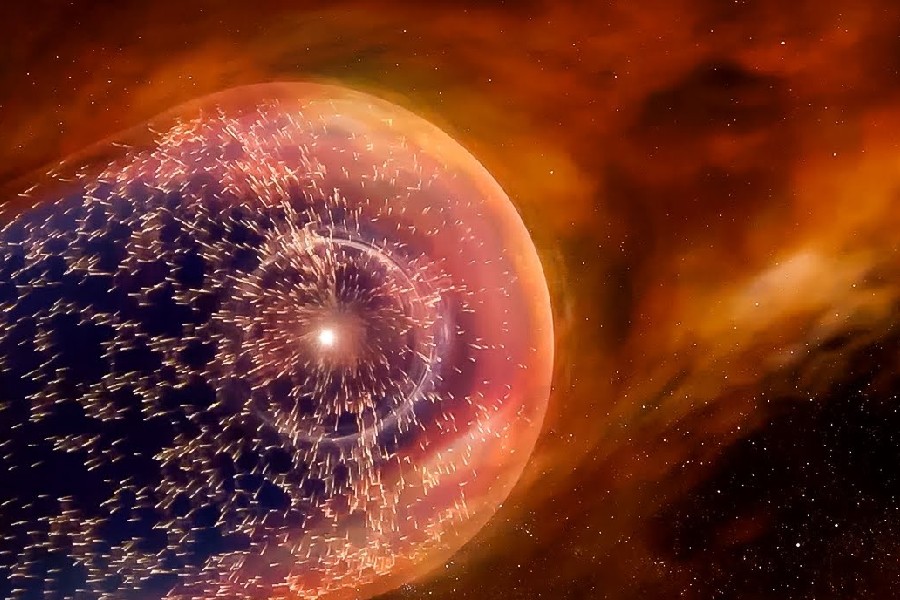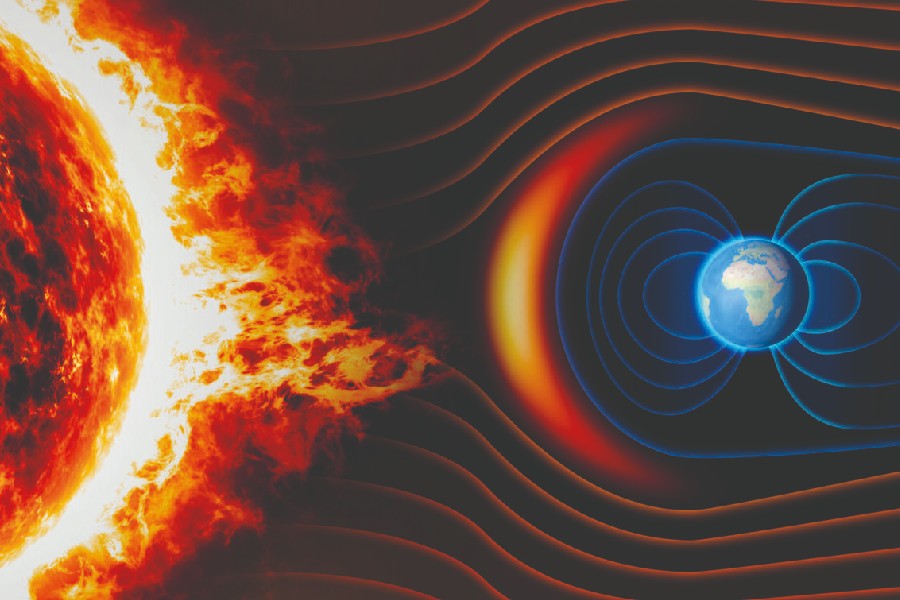The Sun not only fosters life on Earth through light and warmth. It also has an extended magnetic bubble. This bubble shields us from incoming dangers beyond our heliosphere boundaries. But what does the heliosphere protect us from exactly?
What risks does the heliosphere hold at bay? As researchers work to decode the protective role of the heliosphere, they inch closer to understanding how life thrives on Earth amidst the hostility of space.
Studying what Earth is shielded from reveals how delicate the factors are that allow life in an often hostile cosmos. Though the heliosphere provides a protective cocoon, mysteries of similar refuges around distant stars compel us to keep exploring our cosmic neighborhood.

What Does the Heliosphere Protect Us From?
So, what does the heliosphere protect us from? The heliosphere is a protective bubble of solar wind and magnetic fields surrounding our solar system. This bubble shields Earth from intergalactic cosmic rays.
These charged particles emanate from intense cosmic events. Cosmic rays could erode planetary atmospheres. They can bombard organisms with dangerous radiation. Over 90% of these particles are deflected by the heliosphere before reaching Earth and the inner worlds.
This protects life from exposure to full radiation intensities permeating deep space. By understanding the heliosphere’s role as Earth’s shield, we gain perspective on the fine balance allowing life in our solar oasis amidst hazards spanning the hostile universe beyond.
The Heliosphere: Earth’s Cosmic Shield
The heliosphere forms an enormous protective bubble around the solar system. Formed by the solar wind and the Sun’s magnetic field, it wards off over 90% of dangerous galactic cosmic rays. The heliosphere protects the Solar System from powerful radiation coming from the supernovae when the stars explode. This shield prevents atmospheric erosion and biological radiation damage to Earth and the inner worlds.
As interstellar spacecraft finally penetrate the heliosphere’s boundaries, unraveling its precise structure helps contextualize solar weather and activity. This solar activity has ramifications for life thriving under stable illumination from the Sun. Monitoring heliosphere health also aids in predicting its response to future stellar cycles.
Understanding how the heliosphere shields Earth gives insight into the scarcity of worlds that escape cosmic sterilization. Examining this protective bubble aids strategies to safeguard tenuous atmospheres on Mars and icy moons using artificial magnetism – potentially allowing the life on Earth to spread.
As the heliosphere varies in tune with the Sun’s cycles, we can better forecast its impacts. These include shifts in Earth’s climate and radiation levels threatening satellites and astronauts.
The changing heliosphere affects missions venturing into the solar system’s outer limits. Decoding the heliosphere and its eccentric nature interlinks phenomena on both local and grand interstellar scales.
What constitutes the heliosphere
The heliosphere forms through complex interactions between the solar wind and localized interstellar medium. Charged solar particles stream outwards, generating shifting magnetic fields that carve out a protective niche preserving planetary atmospheres.
As the Sun travels the galaxy, collisions with galactic debris winds decelerate its outward movement. Pressure builds until equilibrium forms the heliosphere’s teardrop shape – rounded end facing incoming galactic materials, tapering tail trailing the Sun’s motion direction.
Solar wind and its impact
The solar wind constitutes a steady flux of charged particles blowing out from the Sun at supersonic speeds. Made of separated electrons, protons and traces of heavier ions, this wind shapes surrounding electromagnetic forces.
Variations in solar storm activity modulate the intensity of emitted wind particles across the 11-year solar cycle. The wind prolongs the Sun’s heat bubble far beyond Pluto when unmatched by interstellar gas pressure.
Boundary regions: heliopause, bow shock and termination shock
The heliopause defines the elastic barrier where accumulating solar wind pressure balances that from interstellar winds. Just inside lies the termination shock – where solar particles abruptly slow entering the heliosphere.
Ahead meanwhile, the solar wind’s movement through the surrounding medium forms a bow shock, increasing pressure and temperature dramatically. Together, these dynamic boundaries regulate what crosses into the solar system’s protected harbor.

Shielding Against Cosmic Radiation
The heliosphere bubbles the solar system in a protective plasma, using embedded magnetic fields to deflect charged cosmic rays. These high-energy particles originating from across the galaxy can damage cells and erode unshielded atmospheres.
Without the heliosphere’s diversion, cosmic radiation intensities would increase exponentially. Long-term surface exposure increases the risk of birth defects and cancer in organisms. Meanwhile atmospheric protection dwindles over centuries – threatening climate stability and surface habitability.
Deflecting Galactic Winds
Tenuous galactic winds, composed partly of dust and neutrinos from ancient supernova remnants, travel between star systems. Though pressures stay relatively gentle, the cumulative sandblasting effect still degrades unprotected planets over eons.
As the Sun moves within our galaxy’s star nursery, the expanding heliosphere bow shock plows through and parts this thin medium – preventing erosion of planetary atmospheres and surfaces from persistent exposure to Galactic Core-directed winds through the eons.
Safeguarding Against Interstellar Particles
The void between stars teems with lone high-energy subatomic particles. It also contains macro-scale threats like tumbling rogue comets. Lacking solar system velocities, even lone protons accumulate kinetic energy over eons. This is enough energy to erode unshielded atmospheres.
As the Sun moves through the Milky Way, its protruding heliosphere deflects particles. It magnetically deflects over 90% of the erosive particles. This prevents the particles from continually sandblasting vulnerable worlds. This protection uniquely allows fragile biospheres time to evolve complexity.
Heliosphere and Solar Storms
As solar storms spike in 11-year cycles, solar wind and fields intensify. Bursts of particles influence the heliosphere’s shifting boundaries. The added particles also drive geomagnetic storms. These storms produce beautiful auroras.
The same turbulence-generating auroras also strengthen the heliosphere externally. This fortifies the heliosphere’s magnetic barrier. That barrier keeps out cosmic and Galactic radiation. It prevents radiation intrusion into protected inner planets like Earth during solar storms.
The Dynamic Nature of the Heliosphere
The heliosphere’s shape constantly shifts, responding to complex factors. These factors include solar cycles and local interstellar winds.
Lagged in response to solar changes, the heliosphere’s mutations defend planets accordingly. Its agility ensures effective shifting protection. This protection efficacy continues even as the causes of needed defense fluctuate. Many factors maintain Earth’s cosmic shield integrity across stellar cycles.
The Future of Heliosphere Exploration
Upcoming Interstellar Probe and Heliophysics missions will further probe boundary fluctuation effects from differing angles. The missions plumb external reactions of our stellar shield to shifting solar cycle intensity.
Expanding knowledge of the heliosphere’s mechanisms for modulating cosmic radiation will allow more accurate climate and astronaut health impact predictions. Comparing solar bubble variations also promotes understanding other stars’ radiation shielding properties and linked planet habitability.
Conclusion
The heliosphere shields Earth and neighboring worlds from intense cosmic radiation and abrasive Galactic winds. We now better understand what does the heliosphere protect us from – serving as an indispensable barrier preserving rare planetary habitats across the harsh universe.
We have illuminated the complex dynamics involved in our star generating this life-sustaining protective sphere through perpetual emissions resisting interstellar mediums. Gaining perspectives on the many threats attenuated by the heliosphere’s magnetic defenses reveals how precarious our oasis remains amid the celestial void.
While the heliosphere’s capricious boundaries will continue ebbing and flowing to ancient solar rhythms, deciphering ‘what does the heliosphere protects us from’ compels further awe for the unlikely prosperity shining around us as we voyage with our lonely star.
